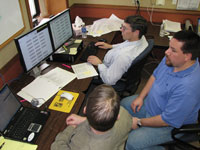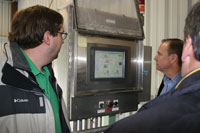
Integrators Jerry Leuthold (clockwise, from top), Keith Hefty and Blane Wheeler of Bachelor Controls model a controls system prior to installation. All three were involved in the Continental Mills batch-control project in Hopkinsville, KY. Source: Bachelor Controls Inc.
When Pepperidge Farm came online with its newest bakery (“Built for speed,” Food Engineering, April 2004), integration costs were half what the organization bore on a greenfield project 12 years earlier. For this year’s Plant of the Year, Barilla America tightened integration time and expense even more, handling process line integration in house and using a material-handling equipment fabricator to network the packaging line (“Ciao, New York,” Food Engineering, April 2008).
Working with a blank canvas is a best-case scenario when installing controls and plant-to-enterprise systems, of course. The challenge is greater in an existing plant, and difficulty increases exponentially when multiple facilities are involved. Consistent methodologies and standardization are reducing the time and cost on retrofits. Efficiencies have cut engineering time in comparable projects 20-30% over the last five years, estimates David J. Blaida, a manager with Matrix Technologies Inc. The Maumee, OH integrator partners with several technology providers, including Rockwell Automation and Wonderware Inc., the controls and HMI standards at both the Barilla and Pepperidge Farm plants.
The operative word is comparable. Although integrators have succeeded in driving out some engineering costs by minimizing repetitive tasks (reusable code being a prime example), the complexity of automation projects is increasing. As managers seek greater functionality from their plant-floor systems and strive for greater integration with company-wide systems, engineering and programming resources are being reallocated.
Hardware standards deliver some economies, but programming standards are where the real savings reside, notes Charles Rastle, food & beverage marketing manager at Milwaukee’s Rockwell Automation Inc. Unfortunately, “spaghetti code” is all too common in many plants, and a standardized controls architecture requires a top-down methodology that “leads you to logical decisions on how you want your processes to run,” he says. Adds Rockwell’s Paul Nowicki, industry application programming lead, “a consistent methodology in how processes run is key to implementing a maintainable standard.”
Rockwell and Wonderware Inc. are among the manufacturing technology providers that have developed libraries of modular, reusable code to push-start integrators and manufacturers down the road to standardized programming. Maintaining those standards over the life of the plant is a significant challenge, however. “Unless you have one guy who says, ‘Thou shalt use this,’ maintaining a standard is almost impossible,” points out Jeff Baxter, vice president with Albany, OR-based Progressive Software Solutions, a key Wonderware integrator. The problem is magnified when a manufacturer has multiple plants, and those are the organizations that stand to get the most value from standards. “If the organization has a corporate engineering staff to enforce standard practices and force them down to the plant level, the savings can be huge,” acknowledges Baxter. Unfortunately, corporate engineering is an endangered species, and automation support can vary widely from one location to another. “Before you know it,” he says, “you’ve got eight plants, and they’re all different.”
While standardization is promoted as a cost-saver, the economies are deferred. In fact, the short-term costs are likely higher. The payback comes over subsequent projects and in multiple plants.
Painstaking planning and rigorous documentation characterized a batch-control conversion undertaken by Sabetha, KS-based Bachelor Controls Inc. at Continental Mills’ Hopkinsville, KY facility two years ago. “There’s no rocket science to what we do,” Bachelor’s Jerry Leuthold, manager of programming, demurely states. There is extensive involvement by both the client and integrator, however. Six months of project planning and system validation preceded a weekend installation at the mill, where Continental’s Krusteaz baking mixes are produced. Bachelor’s engineers and programmers leverage a library “of proven code that has been tested, and you know it’s going to work,” says Leuthold. Still, new issues crop up in every batch-control project, and that creates an opportunity for creativity. Making sure creative codes are tracked and documented is the only way to maintain standards and head off problems later on.
A project directory in which every e-mail, phone call and correspondence is documented is central to Bachelor’s methodology. The disciplined methodology ensures another engineer could implement the same control architecture at another plant or update the existing one.
Hopkinsville was only a few years old when the controls upgrade began. Bachelor originally installed Intellution’s iBatch and iFix programs, worked through some S-88 issues and had documentation that only had to be slightly updated to reconcile in-house changes. A simulation model was created using RSBatch and RSView SE. Three tests of the code were conducted before installation. The final was a “factory test” involving a dozen Continental personnel at Bachelor’s Memphis office. The Continental team devoted a week to monitoring batching performance and HMI and recipe functionality. It gave them an opportunity to throw curves at the new controls in a safe environment.
“It’s a big commitment from the plant, but it’s well worth it,” says Leuthold. The payoff from hundreds of hours of upfront work began with Continental’s next plant upgrade, where a proprietary controls system was replaced.
Software was installed on existing hardware one weekend and new hardware installed about a month later. “One of the big concerns with a weekend start-up is tech support,” Leuthold confides. If fact, the team experienced data logging issues, “but because of our (Rockwell) Solution Provider status, we made it happen” and corrected the problem in time for Monday’s production.

Calmetric’s Paul Fallgren (left) and Don Pearson of Inductive Automation (right) inspect one of the HMIs installed at Bronco Wine’s four production facilities. Licensing costs drove the company to consider a Web-based HMI system from Calmetrics, its system integrator. Source: Inductive Automation.
Best laid plans
Front-end investment is essential if long-term automation costs are to be curbed, controls engineers agree, but that is not a message reaching receptive ears in today’s manufacturing marketplace. If anything, companies want to slash upfront engineering costs. Plant professionals are hard pressed to make the case for both more involvement by in-house staff and the payback from upfront spending on system design.Like Bachelor Controls, Polytron Inc. relies on simulation models to minimize start-up costs and curb capital requirements for future projects. The simulation tool was first applied in 2000 on a packaging line, according to Brent Stromwall, managing partner at the Norcross, GA integrator. “We did our static and dynamic simulation on the codes and motors on a weekend,” delivering a system that would have taken two weeks to implement otherwise. Some manufacturers have returned to Polytron to make electric-code changes in their batch-control models for six years now, ensuring consistency and documentation. But not all: “They want to reduce engineering cost,” shrugs Stromwall. “Someone has to have gone through the midnight routine of changing code to appreciate modeling.”
System integrators exist because manufacturers laid off their own engineers and opted to outsource the work. But instead of treating integration as a professional service, many soon regarded it as a commodity service to be delivered by the low-cost supplier. “Where we have developed long-term relationships, we have driven down client costs,” notes Dean Ford, director of food & beverage automation solutions at Maverick Technologies, Columbia, IL. But that also requires collaboration with the client’s operators, supervisors, IT and maintenance staff. Too often, that is where automation runs aground. Ford cites the plant that experienced a hard-drive crash at 5 p.m. “We could have had them back online by midnight, but we waited 12 hours for IT to give us a password to get access to the IP address to do the diagnostics,” he moans.
Stromwall and Robert Zeigenfuse, president of Exton, PA-based Advanced Automation Inc., emphasize the lifecycle costs of automation. Unfortunately, plant engineers have difficulty in quantifying the savings from faster start-up, elimination of redundant code-writing and improved system diagnostics. “When purchasing gets involved, different people begin introducing different code, and soon it starts looking pretty gnarly,” says Zeigenfuse, who also serves as chairman of the Control System Integrators Association. Consistency is essential for “a robust, maintainable system,” he says.
Each engineer has his or her own take on industry standards. From Ford’s perspective, brand-specific hardware standards provide some savings on replacement parts and total cost of ownership, but those are incidental to a standardized methodology. “Don’t make specs platform specific,” he advises. “If the programming is built around an independent standard like S-88, you have a standard way of handling it over and over that is not dependent on a product platform.”
Hardware is a nominal component of standardization and cost containment, agrees Zeigenfuse. “Design and development is your biggest, fattest low-hanging fruit, and there are no standards.” Whether a manufacturer works with an integrator or relies on internal staff, code management needs to be consistently applied if lifecycle costs are to be minimized.
Proprietary technology is giving way to standardization, allows Stromwall, though any cost savings usually are redirected to new applications. To illustrate, proprietary data cable has given way to Ethernet and Ethernet IP cable, but instead of stringing one HMI to a PLC, now four HMIs are linked, eliminating any savings but giving the end-user greater utility. “We’re a lot farther down the road to common communication protocols,” he concludes, “but there’s still a long way to go to open standards.”
In the meantime, manufacturers must be diligent in enforcing consistency. Regardless of who does the work, a disciplined approach to integration is critical to derive optimum value.
For more information:
Robert Zeigenfuse, Advanced Inc., 610-458-8700
Jerry Leuthold, Bachelor Controls Inc., 785-284-3482,jerry@bachelorcontrols.com
Steve Hechtman, Calmetrics Co., 916-438-8800,steve@calmetrics.com
Mark Sutcliffe, CDC Inc., 305-409-4387,msutcliffe@cdcfactory.com
Dean Ford, Maverick Technologies, 443-876-5217,dean.ford@mavtech.cc
Brandon Henning, GE Fanuc, 434-978-6139,brandon.henning@ge.com
David J. Blaida, Matrix Technologies Inc., 419-897-7206,djblaida@matrixti.com
Lynn W. Craig, Manufacturing Automation Associates Inc., 609-953-0513,< l@lcraig.com
Brent Stromwall, Polytron, 678-328-2955,bstromwall@polytron.com
Jeff Baxter, Progressive Software Solutions Inc., 541-924-1741,jbaxter@ps2inc.com
Charles Rastle, Rockwell Automation Inc., 303-517-8914,cmrastle@ra.rockwell.com